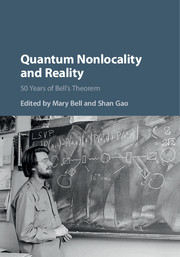Book contents
- Frontmatter
- Contents
- Contributors
- Preface
- Preface
- Part I John Stewart Bell: The Physicist
- Part II Bell's Theorem
- Part III Nonlocality: Illusion or Reality?
- 9 Strengthening Bell's Theorem: Removing the Hidden-Variable Assumption
- 10 Is Any Theory Compatible with the Quantum Predictions Necessarily Nonlocal?
- 11 Local Causality, Probability and Explanation
- 12 The Bell Inequality and the Many-Worlds Interpretation
- 13 Quantum Solipsism and Nonlocality
- 14 Lessons of Bell's Theorem: Nonlocality, Yes; Action at a Distance, Not Necessarily
- 15 Bell Nonlocality, Hardy's Paradox and Hyperplane Dependence
- 16 Some Thoughts on Quantum Nonlocality and Its Apparent Incompatibility with Relativity
- 17 A Reasonable Thing That Just Might Work
- 18 Weak Values and Quantum Nonlocality
- Part IV Nonlocal Realistic Theories
- Index
- References
13 - Quantum Solipsism and Nonlocality
from Part III - Nonlocality: Illusion or Reality?
Published online by Cambridge University Press: 05 September 2016
- Frontmatter
- Contents
- Contributors
- Preface
- Preface
- Part I John Stewart Bell: The Physicist
- Part II Bell's Theorem
- Part III Nonlocality: Illusion or Reality?
- 9 Strengthening Bell's Theorem: Removing the Hidden-Variable Assumption
- 10 Is Any Theory Compatible with the Quantum Predictions Necessarily Nonlocal?
- 11 Local Causality, Probability and Explanation
- 12 The Bell Inequality and the Many-Worlds Interpretation
- 13 Quantum Solipsism and Nonlocality
- 14 Lessons of Bell's Theorem: Nonlocality, Yes; Action at a Distance, Not Necessarily
- 15 Bell Nonlocality, Hardy's Paradox and Hyperplane Dependence
- 16 Some Thoughts on Quantum Nonlocality and Its Apparent Incompatibility with Relativity
- 17 A Reasonable Thing That Just Might Work
- 18 Weak Values and Quantum Nonlocality
- Part IV Nonlocal Realistic Theories
- Index
- References
Summary
Abstract
J.S. Bell's remarkable 1964 theorem showed that any theory sharing the empirical predictions of orthodox quantum mechanics would have to exhibit a surprising – and, from the point of view of relativity theory, very troubling – kind of nonlocality. Unfortunately, even still on this 50th anniversary, many commentators and textbook authors continue to misrepresent Bell's theorem. In particular, one continues to hear the claim that Bell's result leaves open the option of concluding either nonlocality or the failure of some unorthodox “hidden variable” (or “determinism” or “realism”) premise. This mistaken claim is often based on a failure to appreciate the role of the earlier 1935 argument of Einstein, Podolsky, and Rosen in Bell's reasoning. After briefly reviewing this situation, I turn to two alternative versions of quantum theory – the “many worlds” theory of Everett and the quantum Bayesian interpretation of Fuchs, Schack, Caves, and Mermin – that purport to provide actual counterexamples to Bell's claim that nonlocality is required to account for the empirically verified quantum predictions. After analyzing each theory's grounds for claiming to explain the EPR–Bell correlations locally, however, one can see that (despite a number of fundamental differences) the two theories share a common for-all-practical-purposes (FAPP) solipsistic character. This dramatically undermines such theories’ claims to provide a local explanation of the correlations and thus, by concretizing the ridiculous philosophical lengths to which one must go to elude Bell's own conclusion, reinforces the assertion that nonlocality really is required to coherently explain the empirical data.
Introduction
Fifty years ago, in 1964 [1], John Stewart Bell first proved the theorem that has become widely known as “Bell's Theorem” but that Bell himself instead referred to as the “locality inequality theorem” [2]. In Bell's own view, the theorem showed that the empirical predictions of local theories will be constrained by Bell's inequality (or as Bell himself preferred to call it, the “locality inequality”). Hence, nonlocality is a necessary feature of any theory that shares the empirical predictions of standard quantum mechanics.
- Type
- Chapter
- Information
- Quantum Nonlocality and Reality50 Years of Bell's Theorem, pp. 204 - 237Publisher: Cambridge University PressPrint publication year: 2016
References
- 10
- Cited by



